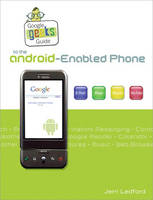
Web Geek's Guide to the Android-Enabled Phone
Que Corporation,U.S. (Verlag)
978-0-7897-3972-8 (ISBN)
- Titel ist leider vergriffen;
keine Neuauflage - Artikel merken
Covers Android 1.5
Make the Most of Your Android-Enabled Phone!
Out of the way BlackBerry. Move over iPhone. There’s a more intelligent alternative to the same old smartphone. Google’s Android mobile phone platform has all the capabilities of these phones and more. With this book, you’ll unlock every bit of power that’s built into the Android phone and learn how to take advantage of the incredibly innovative Android applications pouring into the marketplace. You’ll even learn how to build (and sell) your own new applications.
You’ll begin with a quick, practical tour of the first Android phone–the T-Mobile G1. You won’t just learn how to use your Android phone’s built-in applications, you’ll also learn tips and tricks that’ll make you a power user, fast! From email and YouTube to Google Maps and GPS, if Android can do it, this book will help you do it even better. Are you inspired by Android’s great apps? Create your own! This book gets you started with a complete introduction to Google’s powerful, free Android development toolset!
Covers all this, and more...
Get online with Android’s built-in web browser
Connect via Gmail Mobile–or any other email service you like
Use Android’s core applications, including Contacts, Calendar, Alarm,
Calculator, and Camera
Have fun with Android: from music and video to the hottest games
Add new capabilities to your Android phone using third-party applications
Build your own Android applications including: design tips, tools, coding
explanations, and instructions for publishing via the Android market
Learn time-saving Android keyboard shortcuts
Troubleshoot problems with your Android phone, step-by-step
Jerri Ledford has been a freelance business technology writer for more than 10 years. During that time, more than 1,000 of her articles, profiles, news stories, and reports have appeared online and in print. Her publishing credits include Intelligent Enterprise, Network World, Information Security Magazine, DCM Magazine, CRM Magazine, IT Manager’s Journal, and dozens more. Jerri also develops and teaches technology training courses for both consumer and business users. Some of the course topics she’s been involved with include security, customer service, career skills, and technology for companies such as IBT Financial, Writer’s Village University, Beacon Hill Financial Services, Hewlett-Packard, Sony, and CNET. She is the author of 17 books, including these: The Web Geek’s Guide to Google Chrome Google Powered: Productivity with Online Tools Google Analytics 2.0 In her free time, Jerri travels extensively and enjoys hiking, writing fiction novels, and soaking up the positive ions at the beach with her children. Bill Zimmerly is a retired computer programmer with interests that include writing about and programming Linux-powered gadgets like Android cell phones and Web applications for the Internet. With “tongue in cheek” sarcasm Bill considers himself one of those “unreasonable” men that the great writer Mr. George Bernard Shaw wrote about when he penned the famous line, “The reasonable man adapts himself to the world. The unreasonable man persists in trying to adapt the world to himself. All progress, therefore, depends upon the unreasonable man.” Prasanna Amirthalingam is a software engineer who develops applications on both Java and .NET. He is very passionate about developing applications and loves sharing his passion through technical speaking and technical writing. He has authored exam content for more than 15 certification exams on various Microsoft technologies, including .NET, VSTS, VSTO, and Mobile development, and has been a Microsoft MVP since 2005. He loves travelling and has been working in different countries after starting his technical career in the beautiful islands of Sri Lanka. You can read his blog at www.prasanna.ws.
Introduction 1
Part I: Devices
1 The Theory of the Android Phone 11
The Melding of Google Mobile and Android 13
Today’s Internet Society 16
Bringing It All Together 17
Making Devices Usable 18
Adding Software Applications to the Mix 19
Closing the Door 20
2 Getting to Know Android Phones 21
The T-Mobile G1 22
The Buttons 23
Screen Icons 27
The T-Mobile myTouch 30
Overview of Software and Applications 32
Android in Brief 32
Core Applications 33
Third-Party Apps 36
Device Security 37
Closing the Door 40
3 Basic Use of Your Android Phone 41
Phone Calls 42
Calling Methods 42
Call Capabilities 46
Text Messages, Multimedia Messages, and IMs 49
Text Messages 49
Multimedia Messages 51
Instant Messages 54
To Sync or Not to Sync 56
Syncing with the Web, Not the Desktop 57
You Can Still Sync With the Desktop–Sorta 58
Closing the Door 59
Part II: The Applications
4 Core Applications 63
Connecting with Contacts 64
Adding Contacts 65
Managing Existing Contacts 68
Saving the Date in the Calendar 70
Navigating the Calendar 71
Adding Events 75
Editing and Deleting Events 76
Adding Multiple Calendars 76
Figuring with the Calculator 77
Using the Camera to Capture Pictures 79
Camera Settings 79
Working with Pictures 80
Capturing and Sharing Videos 83
Capturing Video 83
Sharing Videos 84
Closing the Door 84
5 Going Online 85
Getting Connected 86
Connection Is More Than Just the Internet 86
A Bit More on Bluetooth and GPS 87
The Important Stuff: Wi-Fi 91
Understanding the Android Browser 95
Accessing the Browser 95
Browser Controls 97
Link Menus 98
Multiple Page Instances 98
Go to URL 100
Search 100
Bookmarks 102
Refresh 105
Additional Browser Options 105
Settings 107
Closing the Door 111
6 Email Anywhere 113
Introduction to Gmail 114
Accessing Gmail 114
Using Gmail to Send and Receive Messages 117
Reading Messages 117
Receiving Messages 119
Composing and Sending Messages 120
Advanced Gmail Controls 124
Managing Your Email 124
Email Settings 128
Other Email Services 131
Account Settings 132
Message Controls 134
Closing the Door 135
7 Getting Around with GPS and Google Maps 137
An Introduction to the G1’s GPS Capabilities 138
Using Google Maps 138
Getting Directions 139
Additional Options 144
Changing the Map View 144
Other GPS Capabilities 149
Closing the Door 149
8 Breaking Boredom with Entertainment Options 151
Listening to Music 152
Finding Your Music 153
Using Music Controls 154
Putting Music on Your Device 156
Finding Music with Amazon MP3 159
Watching Videos with YouTube 161
Accessing YouTube and Videos 161
Navigating a Video 162
Playing Games and Other Diversions 163
Closing the Door 164
9 Adding Applications to Your Device 165
Finding Apps in the Android Market 167
Downloading and Installing Apps 173
Managing Apps 174
Removing Apps the Easy Way 175
Managing Apps, Including Removal 176
Closing the Door 179
Part III: The Android Platfom
10 Getting to Know Android 183
Understanding Android 184
Key Components of Android 185
Features of the Android Platform 187
The Principles of the Open Handset Alliance 188
The Open Handset Alliance 188
Alliance versus Single Provider 190
Closing The Door 190
11 Developing Native Android Apps 191
Requirements for Development 192
Android Software Development Kit (SDK) 192
Java Standard Edition Development Kit (JDK) 192
Eclipse Integrated Development Environment (IDE) 192
ANT Build Tool 193
Developing Android Applications 193
Setting Up the Development Environment on Windows 193
Setting Up the Development Environment on Linux 195
Making your IDE Android Aware 196
Bringing It All Together: Creating Your First Android Application 198
Creating an Application Using Eclipse 203
Introduction to Android SDK Tools 206
Android Debug Bridge (adb) 206
Android Device Emulator (emulator) 206
Make SD Card (mksdcard) 209
Dalvik Debug Monitor Service (ddms) 209
Android Asset Packaging Tool (aapt) 211
Hierarchy Viewer (hierarchyviewer) 212
UI/Application Exerciser Monkey 213
Trace View 213
SQLite 214
Closing the Door 214
12 Developing Mobile Web Applications 215
Client Code 216
The User-Agent 217
Server Code 225
Security and Authentication 231
Error Handling 232
Designing Web Content for Android 233
WebKit Support for Advanced CSS 233
WebKit Support for JavaScript 234
Performance Tips for Mobile Content 235
Optimal Loading Time 235
Simple Layout 236
Clean Navigation 236
Handling Broken Links 237
Spell-Checking 237
External Links 238
13 Advanced Android Apps 241
Ultimate Portability 242
Make Contact 243
A Few Programmer/Analyst Tips 244
How to Get Advanced Apps 245
Apps by Categories 246
Business Apps 246
Communication Apps 248
Location-Based Apps 249
Entertainment Apps 251
Utility Apps 252
Creating Advanced Apps 253
Appendixes
A Troubleshooting 255
Troubleshooting Device Issues 256
Troubleshooting Application Issues 259
Troubleshooting Design Issues 261
B G1 Keyboard Shortcuts 265
Shortcuts for Navigating Text and Typing 266
Shortcuts for Navigating Applications 266
Browser Shortcuts 267
Index 269
| Erscheint lt. Verlag | 1.10.2009 |
|---|---|
| Sprache | englisch |
| Maße | 229 x 179 mm |
| Gewicht | 458 g |
| Themenwelt | Mathematik / Informatik ► Informatik ► Betriebssysteme / Server |
| Informatik ► Weitere Themen ► Smartphones / Tablets | |
| ISBN-10 | 0-7897-3972-0 / 0789739720 |
| ISBN-13 | 978-0-7897-3972-8 / 9780789739728 |
| Zustand | Neuware |
| Haben Sie eine Frage zum Produkt? |
aus dem Bereich


